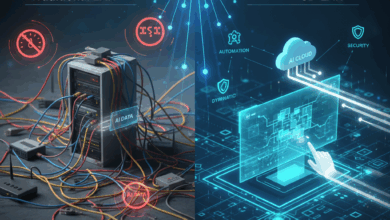Zero Trust vs Traditional Security Models: Why the Perimeter Is Dead in 2025
For decades, cybersecurity has been built on the idea of a strong perimeter — build walls high enough and attackers stay out. But in 2025, the game has changed. The old model is cracking under the weight of modern threats, cloud adoption, and remote work. Enter Zero Trust, a new way of thinking about security that assumes one thing: trust no one and verify everything.
In this article, we’ll explore how Zero Trust security models differ from traditional perimeter-based approaches, why the old ways are no longer enough, and how businesses are adapting to a world where identity, context, and continuous verification are the new foundations of digital trust.
Traditional Security: The Castle-and-Moat Approach
Traditional security models operate like a medieval castle: you build a strong outer wall (the firewall), guard the gates (authentication), and assume that everything inside is trustworthy. This is often called the “castle-and-moat” strategy.
If you’re inside the network, you’re granted access. Once in, users and systems typically face minimal friction when accessing resources.
This model worked — when:
- Employees worked from offices.
- Applications lived in data centers.
- Devices were tightly controlled.
- External threats were clearly “outside” the network.
But none of those assumptions hold in 2025.
Why the Perimeter Is No Longer Enough
The reality today is far more complex. Organizations now operate across:
- Multi-cloud environments
- Remote and hybrid workforces
- Bring-your-own-device (BYOD) policies
- Global third-party ecosystems
Cyber attackers know this — and exploit it. According to Verizon’s latest Data Breach Investigations Report, 74% of breaches involve the human element, often through compromised credentials or lateral movement once inside the network.
So what happens when your network perimeter is breached? Under the traditional model — everything inside is up for grabs.
Enter Zero Trust: Trust Nothing, Verify Everything
Zero Trust flips the script. Instead of assuming users or devices inside the network are safe, Zero Trust starts from a position of zero implicit trust — regardless of location or role.
The core principles of Zero Trust include:
1. Continuous Verification
Always verify access, even after initial login. Every request must be authenticated, authorized, and encrypted.
2. Least Privilege Access
Users only get access to what they need — nothing more. This minimizes the blast radius if an account is compromised.
3. Assume Breach
Operate as if attackers are already inside your network. Segment resources and monitor all activity to reduce damage.
4. Identity Is the New Perimeter
Security decisions are based on user identity, device posture, and contextual signals (like location, behavior, and risk level).
Key Differences: Zero Trust vs Traditional Security
| Feature | Traditional Security | Zero Trust Security |
|---|---|---|
| Trust model | Implicit trust inside the network | No implicit trust; continuous verification |
| Perimeter | Network-based (firewalls, VPNs) | Identity- and context-based |
| Access | Broad once authenticated | Granular and adaptive |
| Visibility | Limited inside the perimeter | Full monitoring and logging of all access |
| Response | Reactive | Proactive, with threat detection built-in |
| Assumption | Trust internal traffic | Assume breach at all times |
Real-World Use Case: Why Zero Trust Matters
Imagine a remote employee logs into your cloud environment from a personal laptop. Under a traditional model, once their VPN connects, they could access a wide swath of applications and files.
With a Zero Trust model:
- The system evaluates the user’s identity, device health, location, and behavior.
- It blocks access unless the device is compliant and the request matches the user’s normal behavior.
- Even if access is granted, it’s scoped to just the tools or data the employee needs.
If that laptop is stolen or the account compromised, damage is limited — and anomalous behavior triggers alerts immediately.
Why Zero Trust Adoption Is Accelerating in 2025
The shift toward Zero Trust is no longer optional. Several forces are driving adoption at record speed:
- Cloud-first strategies: Cloud-native apps don’t fit neatly into traditional network boundaries.
- Remote and hybrid work: Employees access systems from everywhere, making perimeter-based models obsolete.
- Ransomware and credential theft: Threat actors rely on lateral movement — something Zero Trust limits.
- Compliance mandates: Frameworks like NIST 800-207, CISA Zero Trust Maturity Model, and the EU’s NIS2 directive now reference or require Zero Trust principles.
In short, Zero Trust isn’t a buzzword — it’s a business imperative.
Transitioning to Zero Trust: It’s a Journey, Not a Flip of a Switch
Adopting Zero Trust doesn’t mean ripping out everything and starting over. It’s a progressive journey, often beginning with:
- Identity and Access Management (IAM) upgrades
- Multi-factor authentication (MFA) deployment
- Network segmentation
- Endpoint detection and response (EDR)
- Behavioral analytics and risk-based policies
The key is to start with the highest-value areas — like protecting sensitive data, securing privileged accounts, and eliminating overly broad access.
✅ Final Thoughts
In 2025, cybersecurity isn’t about building bigger walls — it’s about building smarter, more adaptable defenses. Zero Trust Security offers a modern solution for a borderless world, grounded in identity, context, and verification.
The perimeter isn’t just porous — it’s dead. And with threats evolving faster than ever, Zero Trust isn’t just the future — it’s the present.
Looking to implement Zero Trust in your organization? Contact Zero Trust Networks to learn how we help businesses of all sizes move from legacy models to modern security architectures — step by step.



